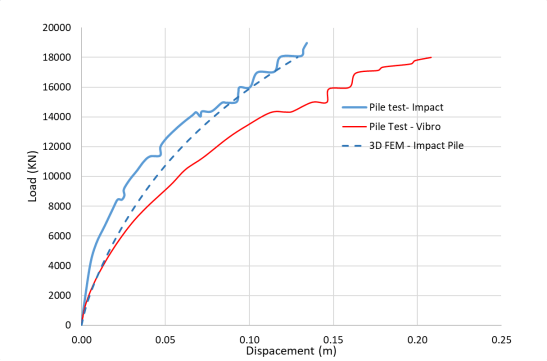At STIXIA, we are passionate about advancing the science of geotechnical engineering to support the growing offshore wind industry. Our latest research, “Effect of Pile Installation on the Numerically Based Soil Reaction Curves of Sandy Soil,” delves into a critical aspect of offshore wind foundation design: the impact of pile installation methods on soil behavior. Link to the paper is below.
The Challenge of Pile Installation
Offshore wind turbines rely on robust foundations, typically monopiles, to withstand harsh marine conditions. However, the method used to install these piles—whether impact driving or vibratory driving—can significantly affect the surrounding soil and, consequently, the foundation’s performance.
Traditional design practices often assume piles are “wished-in-place,” ignoring the effects of installation. While this simplification works for slender piles, it becomes less accurate for the XL-sized monopiles commonly used in offshore wind projects.
Key Findings from the Study
Using data from the VIBRO-Project, a large-scale pile testing initiative, we analyzed the effects of vibratory and impact pile driving on soil reaction curves in dense North Sea sand. Here’s what we discovered:
- Stiffness Differences: Vibratory-driven piles showed lower soil-pile stiffness compared to impact-driven piles, particularly at small and intermediate displacements.
- Ultimate Capacity: Despite the differences in stiffness, the ultimate capacity of the piles remained largely unaffected by the installation method.
- Practical Recommendations: We proposed adjustments to the PISA soil spring parameters to account for the effects of vibratory installation, ensuring safer and more efficient foundation designs.
Why This Research Matters
Understanding the impact of pile installation is crucial for optimizing offshore wind foundations. By incorporating these findings into design practices, we can:
- Reduce Uncertainty: Improve the accuracy of soil reaction predictions, leading to more reliable designs.
- Enhance Efficiency: Optimize pile installation methods to save time and costs.
- Ensure Safety: Develop foundations that perform reliably under real-world conditions.
Looking Ahead
This research is a testament to STIXIA’s commitment to innovation and excellence in the offshore wind industry. By bridging the gap between theory and practice, we aim to support the global transition to renewable energy with cutting-edge engineering solutions.
Stay tuned for more updates on our research and its applications in offshore wind projects. Together, we can build a sustainable future—one foundation at a time.
Join the Conversation
What are your thoughts on the challenges of pile installation in offshore wind projects? How can we further improve foundation design methods? Share your insights in the comments below or connect with us on LinkedIn to continue the discussion.
At STIXIA, we believe that collaboration and innovation are key to unlocking the full potential of offshore wind energy.
This blog post is designed to be engaging, informative, and SEO-friendly, with keywords like “pile installation,” “soil reaction curves,” “offshore wind foundations,” and “PISA method” strategically included. It also highlights STIXIA’s expertise and commitment to innovation, making it a valuable addition to your website.


